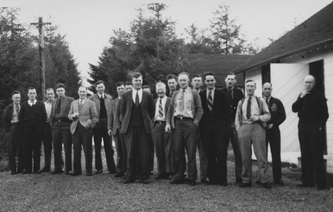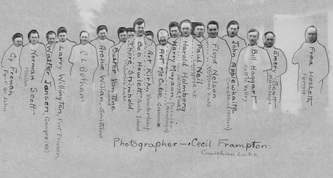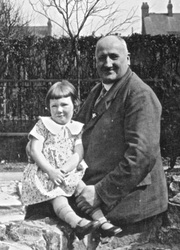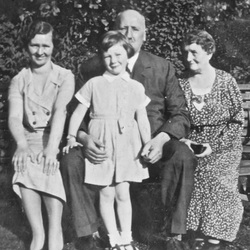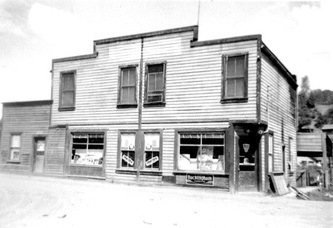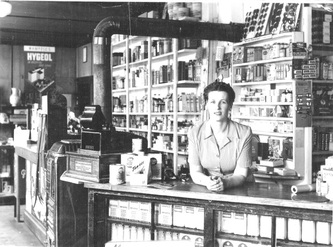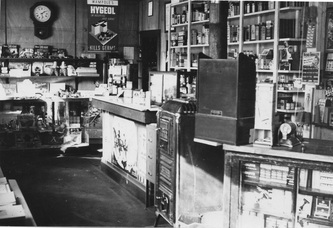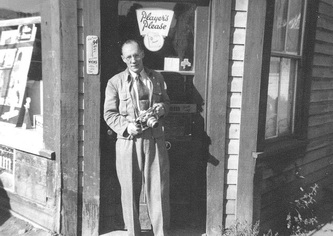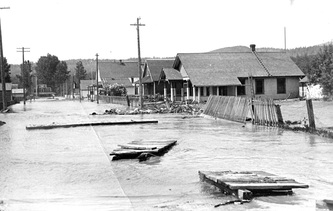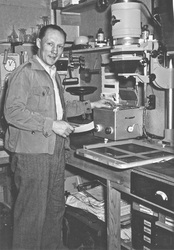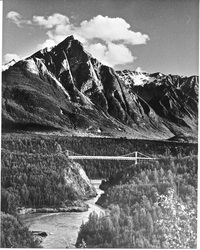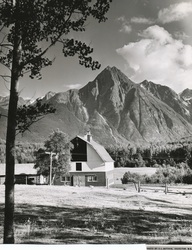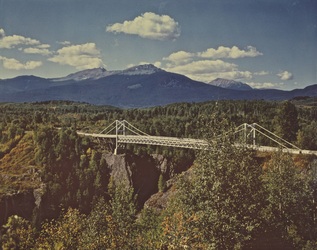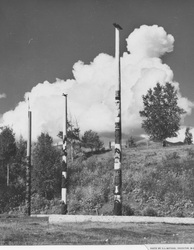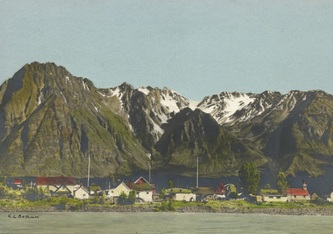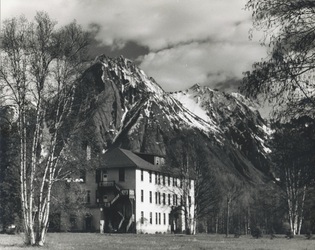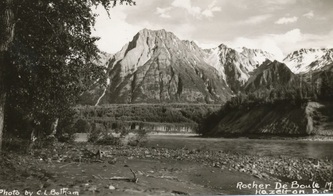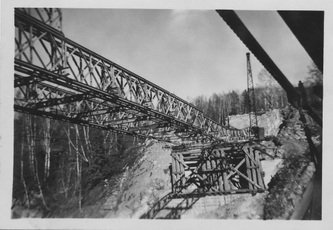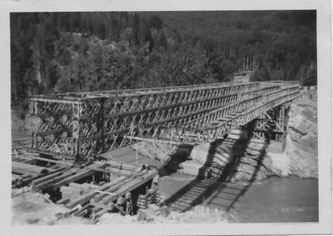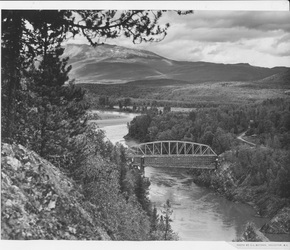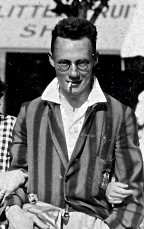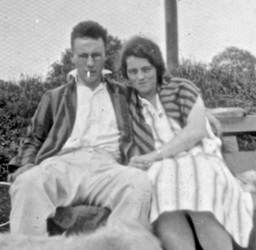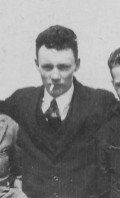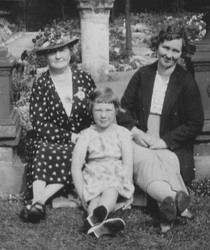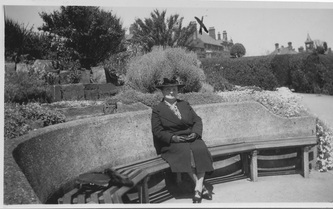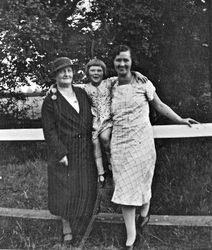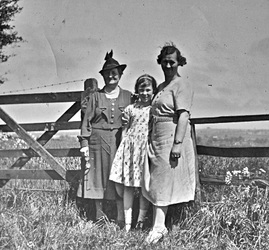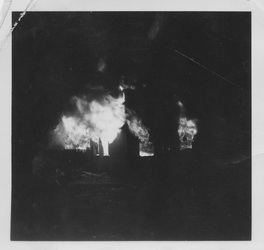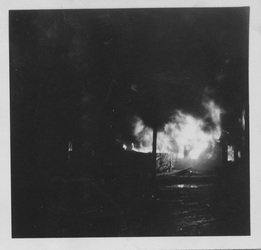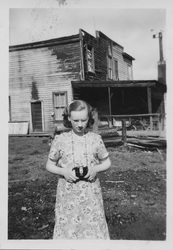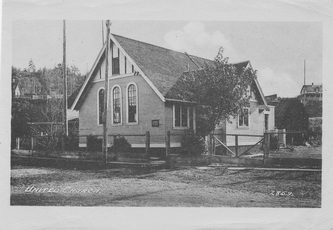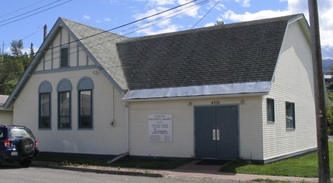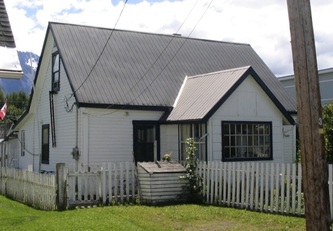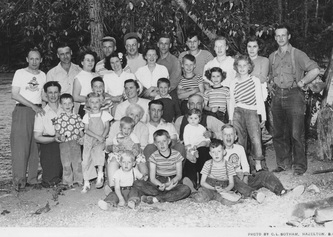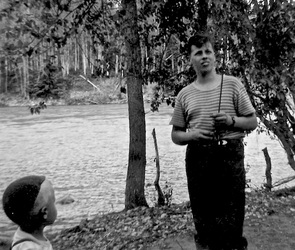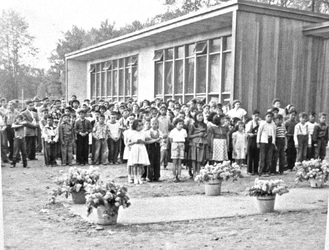Photos above: Left: Hagwilget bridge; Centre: Mt Rocher de Boule from Hospital; Right: family with west flank of Rocher de Boule in background. The colour has suffered the ravages of time, some more than others. All photos by C.L.Botham
Nine - Postwar Hazelton
1945
To all intents and purposes once the war with Germany and Japan was over Marion and Charles could now return to Hazelton. Charles had departed his forestry job at this point, so this was where he returned. They also looked forward to their many friends there with whom they had enjoyed a pleasant social life before the war.
It had also long been obvious that Charles' strategy of joining to be deployed overseas had not worked. And following demobilization the circumstances for returning to England for a visit were still not fortuitous. There was the business of getting reestablished in a war-bruised economy. The boom-times of the fifties were still a few years away, so no matter what he did, prosperity would elude him for a time.
Charles resumed the position of Forest Ranger at Hazelton on 1st October of 1945. His new starting salary was $2340.00 annually, which worked out at the monthly “princely sum” of $195.00/month. Even for those days this was not generous, and certainly not an amount with which a family could afford any extras in their daily life. However, with much economizing Marion could make it do.
Back in Hazelton they found that rental housing was, as in prewar times, almost nonexistent. So, when they found that the small house at Two-Mile belonging to Tom Marshall, that they had lived in before they had left, was still empty, they were thankful to be able to move back into it.
Being two miles outside of Hazelton, and with no bus service, meant that when one needed some item, or to go somewhere, if a car wasn't available then it had to be obtained by walking. Fortunately Marion could usually rely on Charles to drive her to the stores in Hazelton for her groceries, but the children had to walk to and from school every day. Some mornings the children could ride with their father, but he was usually unable to give them a ride and they had to walk to school. He would try to be available to transport them on winter days when the weather was cold or blustery, but on those mornings when he couldn’t, they had to walk. An occasional relief to the prospect of walking a portion of the two miles, would occur when they were picked up by one of the neighbours as they walked to school. When this happened they were always very grateful. The same applied as they were walking home. Of course, it was absolutely unheard in that part of the world for anyone to turn and face the passing cars and BEG for a ride by sticking out your thumb. The custom was to rely on the kindness of neighbours picking you up.
The walk to town wasn’t their favourite, but at least it was all downhill. On the other hand the walk home wasn’t quite as simple, because of the large hills that had to be climbed as you left the river valley and gained altitude to the level where we lived.
First you hiked up the hill from the downtown level to the level of the surrounding Reserva-tion where the natives lived. Then you had to climb the “Big Hill” up to the level of the flat where the fairgrounds and the village cemetery were. Walking three or four hundred metres past the fairgrounds you were then faced by “Hospital Hill”, a longish hill which led you to the hospital level. At the top of hospital hill was the turnoff to Kispiox, which we walked past. Past that turnoff there was a straight level stretch of three or four hundred metres which went past the hospital grounds.
Opposite the hospital, which was set well back on the right, was Gildner’s farm, also set well back, where some of the milk consumed in the area was produced. After the hospital you were faced with “Hospital Stretch”, a quarter mile long straight stretch, the only straight bit of road in that part of the country, where, if the gravel wasn’t too thickly spread, with care drivers could get “up to” 50 or even 60 miles per hour! - for a few moments, and then slow for the curve. At the end of hospital stretch you curved to the right, passed Senden’s farm, and there was our home, always a welcome sight! The total distance – two miles, was sometimes hot, sometimes cold, always too long!
On Charles’ arrival back at “the office” he fit right in with the activities. During his absence his role had been filled by Acting Forest Ranger L.G. Taft, but once again he was the Ranger in charge, while "old" Henry Willan who had been the Assistant Ranger before the war, was still on hand working as before. And now there were other assistants to help with the workload. Henry’s son Laurie was home from his war service where he had served as a Commando. Peter can remember that on a bad weather day when he went to the Forestry office to wait for Charles to go home, Laurie was there. When he asked him to show him how the typewriter worked he kindly obliged. But his dad took a dim view of his bothering him for this trivial purpose and told him to find something else to do.
Another Forestry employee, was Bernard Hindle, a very nice fellow who who lived beside them at Two-Mile with his mother and son Harold. At that time he probably wasn't an Assistant Ranger, but rather a Patrolman, or something. Peter remembers Mrs. Hindle scolding him once because she felt that he was too rough with the “toys” she gave her grandson Harold. She often gave him something to play with, which was often not a toy, Peter remembers that once it was a pair of springy arm-bands, and when he "tried out" the "stretchiness" he wrecked them by stretching them out too far. Harold was a couple of years younger than he was and it was easy for me to get his things from him to “see” them. Her reprimand was all he needed to leave Harold's things alone after that.
Following the war the BC Forest Service prepared for major changes in the way the forest was managed. Returning to “normal” would only mean a temporary change, and as “old” employees returned and new ones were taken on, the Chief Foresters and their assistants in Victoria made plans to make a few reforms in their procedures of their department. It seems likely that at that time they were preparing to manage the planned Tree Farm Licenses, which were to be granted to a number of big companies. In these TFL’s companies were expected to control and to manage vast areas of forest. It was intended that the forest they controlled would be scientifically managed and harvested. Before that could happen, however, they wanted to upgrade the training that their field employees had, to better cope with some of the complexities that were to come.
To do this, they instituted a training program for the existing Rangers, the staff who would interface with the companies then cutting and otherwise using the forest resource, as well as those who would be using it in the future. Consequently, in the period January to April 1946 they held their first postwar Forest Ranger School at Green Timbers, New Westminster, to which Charles and nineteen other Forest Rangers were invited for a four month crash course in Forestry basics. These topics ranged from forest management to insect pests and included many other topics.
At the end of the course it was revealed to them by one of the “brass” from Victoria that the position of Forest Ranger, in other words, their job, was to be phased out, and that in the future their jobs would be done by Foresters trained at University. Obviously, this member had not taken the course in “Morale-boosting 101” because to many of these Rangers this news was very discouraging. In their case, their mother, Marion had been very disappointed to lose Charles again for four months after being alone for 3 ½ years during the war. Charles had interpreted the speaker as meaning these changes would happen within just a short time – probably two or three years. After having barely surviving the Great Depression, and with a family and themselves to support for many years yet, he seriously began to consider what his options were. Should he stay in the Forest Service, or should he try to make a career change?
1945
To all intents and purposes once the war with Germany and Japan was over Marion and Charles could now return to Hazelton. Charles had departed his forestry job at this point, so this was where he returned. They also looked forward to their many friends there with whom they had enjoyed a pleasant social life before the war.
It had also long been obvious that Charles' strategy of joining to be deployed overseas had not worked. And following demobilization the circumstances for returning to England for a visit were still not fortuitous. There was the business of getting reestablished in a war-bruised economy. The boom-times of the fifties were still a few years away, so no matter what he did, prosperity would elude him for a time.
Charles resumed the position of Forest Ranger at Hazelton on 1st October of 1945. His new starting salary was $2340.00 annually, which worked out at the monthly “princely sum” of $195.00/month. Even for those days this was not generous, and certainly not an amount with which a family could afford any extras in their daily life. However, with much economizing Marion could make it do.
Back in Hazelton they found that rental housing was, as in prewar times, almost nonexistent. So, when they found that the small house at Two-Mile belonging to Tom Marshall, that they had lived in before they had left, was still empty, they were thankful to be able to move back into it.
Being two miles outside of Hazelton, and with no bus service, meant that when one needed some item, or to go somewhere, if a car wasn't available then it had to be obtained by walking. Fortunately Marion could usually rely on Charles to drive her to the stores in Hazelton for her groceries, but the children had to walk to and from school every day. Some mornings the children could ride with their father, but he was usually unable to give them a ride and they had to walk to school. He would try to be available to transport them on winter days when the weather was cold or blustery, but on those mornings when he couldn’t, they had to walk. An occasional relief to the prospect of walking a portion of the two miles, would occur when they were picked up by one of the neighbours as they walked to school. When this happened they were always very grateful. The same applied as they were walking home. Of course, it was absolutely unheard in that part of the world for anyone to turn and face the passing cars and BEG for a ride by sticking out your thumb. The custom was to rely on the kindness of neighbours picking you up.
The walk to town wasn’t their favourite, but at least it was all downhill. On the other hand the walk home wasn’t quite as simple, because of the large hills that had to be climbed as you left the river valley and gained altitude to the level where we lived.
First you hiked up the hill from the downtown level to the level of the surrounding Reserva-tion where the natives lived. Then you had to climb the “Big Hill” up to the level of the flat where the fairgrounds and the village cemetery were. Walking three or four hundred metres past the fairgrounds you were then faced by “Hospital Hill”, a longish hill which led you to the hospital level. At the top of hospital hill was the turnoff to Kispiox, which we walked past. Past that turnoff there was a straight level stretch of three or four hundred metres which went past the hospital grounds.
Opposite the hospital, which was set well back on the right, was Gildner’s farm, also set well back, where some of the milk consumed in the area was produced. After the hospital you were faced with “Hospital Stretch”, a quarter mile long straight stretch, the only straight bit of road in that part of the country, where, if the gravel wasn’t too thickly spread, with care drivers could get “up to” 50 or even 60 miles per hour! - for a few moments, and then slow for the curve. At the end of hospital stretch you curved to the right, passed Senden’s farm, and there was our home, always a welcome sight! The total distance – two miles, was sometimes hot, sometimes cold, always too long!
On Charles’ arrival back at “the office” he fit right in with the activities. During his absence his role had been filled by Acting Forest Ranger L.G. Taft, but once again he was the Ranger in charge, while "old" Henry Willan who had been the Assistant Ranger before the war, was still on hand working as before. And now there were other assistants to help with the workload. Henry’s son Laurie was home from his war service where he had served as a Commando. Peter can remember that on a bad weather day when he went to the Forestry office to wait for Charles to go home, Laurie was there. When he asked him to show him how the typewriter worked he kindly obliged. But his dad took a dim view of his bothering him for this trivial purpose and told him to find something else to do.
Another Forestry employee, was Bernard Hindle, a very nice fellow who who lived beside them at Two-Mile with his mother and son Harold. At that time he probably wasn't an Assistant Ranger, but rather a Patrolman, or something. Peter remembers Mrs. Hindle scolding him once because she felt that he was too rough with the “toys” she gave her grandson Harold. She often gave him something to play with, which was often not a toy, Peter remembers that once it was a pair of springy arm-bands, and when he "tried out" the "stretchiness" he wrecked them by stretching them out too far. Harold was a couple of years younger than he was and it was easy for me to get his things from him to “see” them. Her reprimand was all he needed to leave Harold's things alone after that.
Following the war the BC Forest Service prepared for major changes in the way the forest was managed. Returning to “normal” would only mean a temporary change, and as “old” employees returned and new ones were taken on, the Chief Foresters and their assistants in Victoria made plans to make a few reforms in their procedures of their department. It seems likely that at that time they were preparing to manage the planned Tree Farm Licenses, which were to be granted to a number of big companies. In these TFL’s companies were expected to control and to manage vast areas of forest. It was intended that the forest they controlled would be scientifically managed and harvested. Before that could happen, however, they wanted to upgrade the training that their field employees had, to better cope with some of the complexities that were to come.
To do this, they instituted a training program for the existing Rangers, the staff who would interface with the companies then cutting and otherwise using the forest resource, as well as those who would be using it in the future. Consequently, in the period January to April 1946 they held their first postwar Forest Ranger School at Green Timbers, New Westminster, to which Charles and nineteen other Forest Rangers were invited for a four month crash course in Forestry basics. These topics ranged from forest management to insect pests and included many other topics.
At the end of the course it was revealed to them by one of the “brass” from Victoria that the position of Forest Ranger, in other words, their job, was to be phased out, and that in the future their jobs would be done by Foresters trained at University. Obviously, this member had not taken the course in “Morale-boosting 101” because to many of these Rangers this news was very discouraging. In their case, their mother, Marion had been very disappointed to lose Charles again for four months after being alone for 3 ½ years during the war. Charles had interpreted the speaker as meaning these changes would happen within just a short time – probably two or three years. After having barely surviving the Great Depression, and with a family and themselves to support for many years yet, he seriously began to consider what his options were. Should he stay in the Forest Service, or should he try to make a career change?
1946
Ten months after he had returned to civilian life, Charles received a significant cable. The cable informed him that his father, the great Ebenezer, "Grandad in England," as the children thought of him, had died on July 16 1946, at the age of 73.
To Charles, his father’s death aroused a mixed reaction. One the one hand he had never again seen his father after his original departure from England. And now he never would. He must have had many regrets cross his mind. If he had not been so stubborn maybe he could have made the trip. But he had his family to consider. He couldn’t have left them.
He had tried to make it back to his parents by enlisting in the air force and volunteering for overseas service. He had joined the air force specifically, thinking that he would probably be able to obtain a transfer to Britain. But, it had taken time to be trained, and the personnel that had been sent overseas were always a lot younger than he was. They had sent over aircrew, but he had not only avoided the role of an aircrew member, but also his age, being greater than those selected for service overseas, had been against him.
Meanwhile, at home that fall, when the two older children returned to school, Jimmy, the youngest of the family, was also registered and found himself regularly attending Grade One in the town's primary school. Fortunately it was not long for all three children that the family moved to town which made travelling to school each day very easy
Ten months after he had returned to civilian life, Charles received a significant cable. The cable informed him that his father, the great Ebenezer, "Grandad in England," as the children thought of him, had died on July 16 1946, at the age of 73.
To Charles, his father’s death aroused a mixed reaction. One the one hand he had never again seen his father after his original departure from England. And now he never would. He must have had many regrets cross his mind. If he had not been so stubborn maybe he could have made the trip. But he had his family to consider. He couldn’t have left them.
He had tried to make it back to his parents by enlisting in the air force and volunteering for overseas service. He had joined the air force specifically, thinking that he would probably be able to obtain a transfer to Britain. But, it had taken time to be trained, and the personnel that had been sent overseas were always a lot younger than he was. They had sent over aircrew, but he had not only avoided the role of an aircrew member, but also his age, being greater than those selected for service overseas, had been against him.
Meanwhile, at home that fall, when the two older children returned to school, Jimmy, the youngest of the family, was also registered and found himself regularly attending Grade One in the town's primary school. Fortunately it was not long for all three children that the family moved to town which made travelling to school each day very easy
1947
But from death arises new life. His father’s death appeared to make possible a viable alternative to his forestry job. It soon became apparent that he had inherited a sum of money. So, after considering his all-too-few other options, and with the knowledge that he was in the possession of this inheritance, he decided that he would go into business for himself.
Ironically he would use the training he had received by working with his father in the business in England, and set up in a store somewhere in the area. Upon inquiry he discovered that the drug store in Hazelton, known as the Up-To-Date Drug Store, was available for purchase. Buying a going concern was better than trying to start a business from scratch so he made some inquiries to test the efficacy of buying this store.
In speaking to the owner A.O. McDonald he discovered that he could meet his conditions, so he made an offer. Charles never divulged what form the negotiations took, or what the purchase price was but on October 1st (Jim’s 6th birthday) he took over the store, renaming it the Up-To-Date Store as he had had no pharmaceutical training, and he would have to operate it without the pharmacy.
And with this transaction the family moved from Two-Mile into the living quarters located behind and above the store. The children were delighted at this as they now had a much shorter journey to school – Ann and Peter now lived within twenty feet of the building housing 25 Grade 5 to 8 pupils, where they were registered.
It's not clear if Mr. McDonald had also handled house and general insurance, or who had sold it, but in the effort to increase his profitability Charles decided that he could also handle an insurance business. Accordingly, on November 1st of 1946 he took over this insurance agency. How much this increased his workload is not clear, but he did spend much of his time in the office part of the store.
Winter was not an easy season in Hazelton. Not only was the weather often very cold for long periods, but when buildings of the vintage of that store were being built, insulation was not used. In fact it wasn’t even invented. Some builders used shavings in the walls between the 2 x 4 studs, but more often the walls were only lined with newspaper, so the occupants had to rely on well stoked fires to keep the living space warm. In the case of their store, many of the patent medicine products on the shelves had a water base so it was even more important than usual to keep the interior temperature above freezing. It turned out that in the winter their attention to stoking the stoves and heaters in the store was to take a lot of effort. As for Peter, his job was to chop the firewood and keep the wood-boxes and coal scuttles filled so the fire-makers had plenty of fuel on hand.
In his diary Charles’ made a comment about those days of 1947: “Marion and I were struggling to make the business a paying proposition, working till late every night, and always seeming to be one jump behind on the bills.” The summer of 1947 was a dull wet summer. By contrast that winter, 1947-48 was extremely cold including a spell of 50 degrees below zero, and where the temperature never ever rose above 20 below Fahrenheit for six weeks, even in the middle of the day.
But from death arises new life. His father’s death appeared to make possible a viable alternative to his forestry job. It soon became apparent that he had inherited a sum of money. So, after considering his all-too-few other options, and with the knowledge that he was in the possession of this inheritance, he decided that he would go into business for himself.
Ironically he would use the training he had received by working with his father in the business in England, and set up in a store somewhere in the area. Upon inquiry he discovered that the drug store in Hazelton, known as the Up-To-Date Drug Store, was available for purchase. Buying a going concern was better than trying to start a business from scratch so he made some inquiries to test the efficacy of buying this store.
In speaking to the owner A.O. McDonald he discovered that he could meet his conditions, so he made an offer. Charles never divulged what form the negotiations took, or what the purchase price was but on October 1st (Jim’s 6th birthday) he took over the store, renaming it the Up-To-Date Store as he had had no pharmaceutical training, and he would have to operate it without the pharmacy.
And with this transaction the family moved from Two-Mile into the living quarters located behind and above the store. The children were delighted at this as they now had a much shorter journey to school – Ann and Peter now lived within twenty feet of the building housing 25 Grade 5 to 8 pupils, where they were registered.
It's not clear if Mr. McDonald had also handled house and general insurance, or who had sold it, but in the effort to increase his profitability Charles decided that he could also handle an insurance business. Accordingly, on November 1st of 1946 he took over this insurance agency. How much this increased his workload is not clear, but he did spend much of his time in the office part of the store.
Winter was not an easy season in Hazelton. Not only was the weather often very cold for long periods, but when buildings of the vintage of that store were being built, insulation was not used. In fact it wasn’t even invented. Some builders used shavings in the walls between the 2 x 4 studs, but more often the walls were only lined with newspaper, so the occupants had to rely on well stoked fires to keep the living space warm. In the case of their store, many of the patent medicine products on the shelves had a water base so it was even more important than usual to keep the interior temperature above freezing. It turned out that in the winter their attention to stoking the stoves and heaters in the store was to take a lot of effort. As for Peter, his job was to chop the firewood and keep the wood-boxes and coal scuttles filled so the fire-makers had plenty of fuel on hand.
In his diary Charles’ made a comment about those days of 1947: “Marion and I were struggling to make the business a paying proposition, working till late every night, and always seeming to be one jump behind on the bills.” The summer of 1947 was a dull wet summer. By contrast that winter, 1947-48 was extremely cold including a spell of 50 degrees below zero, and where the temperature never ever rose above 20 below Fahrenheit for six weeks, even in the middle of the day.
1948
With the spring of 1948, the melting snow produced a larger volume of meltwater than had been experienced in a long time. So with the coming of spring we heard that there was flooding all over BC. In Hazelton the river bank on the edge of town was in even greater danger than usual of being washed away, and only the intervention with loads of rock known as rip-rap dumped over the bank to protect the soil, reduced the bank losses to little or none. For this the kids had a wonderful day off school when they went with the truckers to pick up rocks on the edge of the local mountain roads and then take them to dump them over the banks into the river.
It was during his time in the store that Charles decided to turn to one of his hobbies to make it profitable. He had always been interested and somewhat creative in photographic activities, so he decided then to take advantage of Hazelton’s beautiful setting and produce photographs of it, to offer for sale in the store. For this purpose he bought a good camera, a Kodak Medalist II, with a good Ektar lens, and a good quality enlarger. He reconstructed part of the space behind the store and built a darkroom. Then with the purchase of numerous accessories, including a photographic dryer, he began to produce beautiful pictures, usually of the mountains, of which he made enlargements, mounted them in mounts or in frames, and set them out on the counter in front for tourists to see and purchase if they liked them. He also bought photographic watercolours to colour the black and white photos, which was quite the fashion in those days.
Charles’ enlarged photographs of the Hazelton scenery were quite a hit. Peter has no idea how much he made by selling them, but he probably made back all the cost of his good equipment, and paid for the time he spent preparing and producing them. And not only did he produce beautiful scenes, but he also applied his photographic skills in other areas. He took portrait photos of some of the local residents, as well as many of their children. He photographed the industrial processes in at least one of the mines. He took numerous photos around the hospital to show the conditions and the patients in their wards. And when the government gave a contract for the new Four-Mile bridge, eventually renamed the Anlaw Bridge, to an out-of-area bridge building company, he attended the construction site on an almost daily basis for several weeks and photographed the process, eventually selling the company a set of high quality photographs which illustrated the steps involved in the construction of the bridge, for their records and use.
Charles and Marion found that keeping the store out of the red and making it pay was not a trivial process. After the war the world’s economy took some years to begin growing. Many of the conditions of the Depression were still felt, and the production of the types of products which were appropriate and necessary for winning a war suddenly stopped. Until jobs in the country were created, there was little money in people’s pockets for them to be consumers. In a tiny backwater like Hazelton jobs have always been scarce, and following the war they were even less available.
So Charles and Marion struggled to build the business. Without stock to sell they could make no profit. So they brought stock in on credit, and then lived on the edge of survival trying to sell enough to pay for it. And this was constant. There was always some “bank draft” whose conditions had to be met and the amount paid.
The types of things they sold mostly were patent medicines and treatments not needing a prescription, magazines and candy, gift items, and souvenirs to the tourists who came through in the summer. Their most profitable time each year was when the local natives who, following their accustomed practices each summer, returned from working in the canneries and on the fishing boats at the coast. If the catch had been good then everyone had lots of money to spend and the stock moved, and new stock could be ordered. Of course, Christmas was the other season where if the year was going to be profitable they had to do it then.
But the fishing season did not end until September or October. In an effort to stimulate some cash flow before autumn arrived on April 15th Charles seized upon the opportunity to take on the position of town Postmaster, when Matt Myros, the owner of the business across the street decided he could no longer do it. Running the Post Office entailed spending many hours away from the store. He did have a clerk hired for waiting on postal customers, but the Post Office, which was the government department that provided the postal service, required that books be kept which had to be balanced on a daily basis, or the owner-operator could get into a great deal of trouble. One of the men who succeeded Charles in the post office, discovered this when a surprise audit found a condition where a temporary shortage in the funds on hand was suspected.
But operating the Post Office wasn’t exactly a piece of cake. That spring of 1948 when there were severe floods all through BC, the mail service was badly disrupted. Once again, Charles found that he had to put in a great effort to keep the post office running and unfortunately was getting little in return for his efforts. Eventually when those difficulties passed things got back to normal, and the situation was somewhat eased.
But their fortunes soared when the fall came and the natives returned from the coast. The fishing season had been very good and many of the returnees had money in their pockets. Charles said later that it was an answer to their prayers. They had been faced with what seemed to be insurmountable financial problems, and suddenly they were solved! They were able to pay their bills and had stock left over on the shelves. And they were also able to order Christmas stock.
Unfortunately, the personal costs of the difficult times they had experienced had taken a severe toll on Marion and Charles, particularly on the latter. During the war Charles had noticed an increasing shortness of breath. At first the doctors he consulted had called it asthma, a type of allergy where the lungs are affected. However, as the war wore on his condition continued to worsen, and consulting with specialists the diagnosis was that he had the more serious condition of emphysema.
Emphysema is a condition where the alveoli, the sacs in the lungs which take up the oxygen, lose their ability to absorb oxygen. At the same time the walls of the lungs lose their elasticity so that while the diaphragm enables the lungs to pull in air, that air is not readily expelled, an inefficiency which leads to a severe inability to breathe normally.
Charles had long been a smoker. In many of the photographs taken in England in which he appears with his friends, or singly, he has a cigarette in his hand. In those days smoking was so accepted that when the management of his previous employer, the Forest Service, wanted to be supportive of his efforts while serving in the air force, they periodically sent cartons of cigarettes to him wherever he was located.
As a result of the stresses of the store and post office, and his declining health, Charles and Marion were finding that the post office and store were too much for them to handle. 1949 turned out to be another cold winter, which brought its own types of stress. As a result, effective February 28th he resigned as Postmaster which was taken over by Ken Miller.
With the spring of 1948, the melting snow produced a larger volume of meltwater than had been experienced in a long time. So with the coming of spring we heard that there was flooding all over BC. In Hazelton the river bank on the edge of town was in even greater danger than usual of being washed away, and only the intervention with loads of rock known as rip-rap dumped over the bank to protect the soil, reduced the bank losses to little or none. For this the kids had a wonderful day off school when they went with the truckers to pick up rocks on the edge of the local mountain roads and then take them to dump them over the banks into the river.
It was during his time in the store that Charles decided to turn to one of his hobbies to make it profitable. He had always been interested and somewhat creative in photographic activities, so he decided then to take advantage of Hazelton’s beautiful setting and produce photographs of it, to offer for sale in the store. For this purpose he bought a good camera, a Kodak Medalist II, with a good Ektar lens, and a good quality enlarger. He reconstructed part of the space behind the store and built a darkroom. Then with the purchase of numerous accessories, including a photographic dryer, he began to produce beautiful pictures, usually of the mountains, of which he made enlargements, mounted them in mounts or in frames, and set them out on the counter in front for tourists to see and purchase if they liked them. He also bought photographic watercolours to colour the black and white photos, which was quite the fashion in those days.
Charles’ enlarged photographs of the Hazelton scenery were quite a hit. Peter has no idea how much he made by selling them, but he probably made back all the cost of his good equipment, and paid for the time he spent preparing and producing them. And not only did he produce beautiful scenes, but he also applied his photographic skills in other areas. He took portrait photos of some of the local residents, as well as many of their children. He photographed the industrial processes in at least one of the mines. He took numerous photos around the hospital to show the conditions and the patients in their wards. And when the government gave a contract for the new Four-Mile bridge, eventually renamed the Anlaw Bridge, to an out-of-area bridge building company, he attended the construction site on an almost daily basis for several weeks and photographed the process, eventually selling the company a set of high quality photographs which illustrated the steps involved in the construction of the bridge, for their records and use.
Charles and Marion found that keeping the store out of the red and making it pay was not a trivial process. After the war the world’s economy took some years to begin growing. Many of the conditions of the Depression were still felt, and the production of the types of products which were appropriate and necessary for winning a war suddenly stopped. Until jobs in the country were created, there was little money in people’s pockets for them to be consumers. In a tiny backwater like Hazelton jobs have always been scarce, and following the war they were even less available.
So Charles and Marion struggled to build the business. Without stock to sell they could make no profit. So they brought stock in on credit, and then lived on the edge of survival trying to sell enough to pay for it. And this was constant. There was always some “bank draft” whose conditions had to be met and the amount paid.
The types of things they sold mostly were patent medicines and treatments not needing a prescription, magazines and candy, gift items, and souvenirs to the tourists who came through in the summer. Their most profitable time each year was when the local natives who, following their accustomed practices each summer, returned from working in the canneries and on the fishing boats at the coast. If the catch had been good then everyone had lots of money to spend and the stock moved, and new stock could be ordered. Of course, Christmas was the other season where if the year was going to be profitable they had to do it then.
But the fishing season did not end until September or October. In an effort to stimulate some cash flow before autumn arrived on April 15th Charles seized upon the opportunity to take on the position of town Postmaster, when Matt Myros, the owner of the business across the street decided he could no longer do it. Running the Post Office entailed spending many hours away from the store. He did have a clerk hired for waiting on postal customers, but the Post Office, which was the government department that provided the postal service, required that books be kept which had to be balanced on a daily basis, or the owner-operator could get into a great deal of trouble. One of the men who succeeded Charles in the post office, discovered this when a surprise audit found a condition where a temporary shortage in the funds on hand was suspected.
But operating the Post Office wasn’t exactly a piece of cake. That spring of 1948 when there were severe floods all through BC, the mail service was badly disrupted. Once again, Charles found that he had to put in a great effort to keep the post office running and unfortunately was getting little in return for his efforts. Eventually when those difficulties passed things got back to normal, and the situation was somewhat eased.
But their fortunes soared when the fall came and the natives returned from the coast. The fishing season had been very good and many of the returnees had money in their pockets. Charles said later that it was an answer to their prayers. They had been faced with what seemed to be insurmountable financial problems, and suddenly they were solved! They were able to pay their bills and had stock left over on the shelves. And they were also able to order Christmas stock.
Unfortunately, the personal costs of the difficult times they had experienced had taken a severe toll on Marion and Charles, particularly on the latter. During the war Charles had noticed an increasing shortness of breath. At first the doctors he consulted had called it asthma, a type of allergy where the lungs are affected. However, as the war wore on his condition continued to worsen, and consulting with specialists the diagnosis was that he had the more serious condition of emphysema.
Emphysema is a condition where the alveoli, the sacs in the lungs which take up the oxygen, lose their ability to absorb oxygen. At the same time the walls of the lungs lose their elasticity so that while the diaphragm enables the lungs to pull in air, that air is not readily expelled, an inefficiency which leads to a severe inability to breathe normally.
Charles had long been a smoker. In many of the photographs taken in England in which he appears with his friends, or singly, he has a cigarette in his hand. In those days smoking was so accepted that when the management of his previous employer, the Forest Service, wanted to be supportive of his efforts while serving in the air force, they periodically sent cartons of cigarettes to him wherever he was located.
As a result of the stresses of the store and post office, and his declining health, Charles and Marion were finding that the post office and store were too much for them to handle. 1949 turned out to be another cold winter, which brought its own types of stress. As a result, effective February 28th he resigned as Postmaster which was taken over by Ken Miller.
1949
When Charles decided that the announced phasing out of the position of Ranger meant the end of his job, his decision taken to ensure that he would have no break in his income, was to buy a store in Old Hazelton. Of course, one of his goals had been to get back to England to visit his mother. The store did not quickly achieve the degree of profitability which he would have needed to afford the trip, and then in March 19 of 1949, he received word that his beloved mother had died at the age of 79. Again he was heartbroken but in spite of this blow he continued on. Of course, as with his father, he had never seen her again, and, of course, was unable to return to England to participate in the conclusion of her affairs. It all had to be done by his sister Margery and the lawyers. Once again the children were kept out of any knowledge of the proceedings so they could only roughly guess as to what happened.
What they have surmised was that there was a fairly substantial estate, which was divided somehow between Charles and Margery. Margery was able to buy a small cottage in the seaside village of Sutton-on-Sea on the coast of Lincolnshire, where she lived out her life growing flowers and enjoying a quiet seaside life. On the other hand once Charles had sold the store, which he did in 1951, he was able to pay cash for the house they acquired in Smithers, and have a small addition built on it. But this is getting ahead of the story.
When Charles decided that the announced phasing out of the position of Ranger meant the end of his job, his decision taken to ensure that he would have no break in his income, was to buy a store in Old Hazelton. Of course, one of his goals had been to get back to England to visit his mother. The store did not quickly achieve the degree of profitability which he would have needed to afford the trip, and then in March 19 of 1949, he received word that his beloved mother had died at the age of 79. Again he was heartbroken but in spite of this blow he continued on. Of course, as with his father, he had never seen her again, and, of course, was unable to return to England to participate in the conclusion of her affairs. It all had to be done by his sister Margery and the lawyers. Once again the children were kept out of any knowledge of the proceedings so they could only roughly guess as to what happened.
What they have surmised was that there was a fairly substantial estate, which was divided somehow between Charles and Margery. Margery was able to buy a small cottage in the seaside village of Sutton-on-Sea on the coast of Lincolnshire, where she lived out her life growing flowers and enjoying a quiet seaside life. On the other hand once Charles had sold the store, which he did in 1951, he was able to pay cash for the house they acquired in Smithers, and have a small addition built on it. But this is getting ahead of the story.
1950
1950 was another cold winter, which Charles recorded as a “record” cold winter. But business was good. I don’t know why, but it seems that people had money – the fish season, tourists, maybe lumber and poles were being produced and shipped out, but they had a good fall and Christmas..
On March 2 the building next door to their store that was used as a schoolroom for Grades 5, 6, 7, & 8, in which Ann and Peter went to school, burned down. At the time they didn’t hear what had caused the fire, but many years later some old school friends of his revealed to him that one of the local boys, the son of their erstwhile landlord at Two-Mile, had been playing with matches and somehow managed to ignite something which led to the larger conflagration.
Their experience with the fire began about 3 a.m. when the sonorous tones of the town fire bell began to sound. The bell was located about a hundred yards from their bedroom window, so it woke Peter up immediately. He will never forget its sound or the reddish glow on his bedroom window. He leaped from his bed and seeing the flames, shouted, “The school’s on fire!”
This started an orgy of movement. Charles headed for the office to get irreplaceable papers, Marion began to pack suitcases and then things from the kitchen. People showed up to begin removing stock from the store to a safe place (possibly).
Peter remembers standing in the kitchen and watching the wooden frames of the small panes of glass in the kitchen window burning. In the store people began to remove the heavy glass showcases, when Charles shouted out, “No, leave those!” He was criticised later, and some drew the conclusion that he must have set the fire himself, because he wanted everything to burn for the insurance he would get. But, as he explained, he knew how difficult those heavy cases were to move, and he didn’t want them stuck in the doors with people trapped inside.
Someone got the bright idea to remove the kitchen range, but there were several difficulties with that. It was an oil-burning range, and Charles had fixed it so that not only was it connected with tubing to the oil tank outside, but also to a hot water tank. He was always trying to improve things. He had run tubing from the hot water tank, which was located in the bathroom, to the stove, and then in a spiral around the pot inside the firebox where the oil burned. By this means the fire would heat the water which when warm would rise and flow to the tank, so we would have hot, or at least warm water in the water tank.
By the time that night was over our building had been badly damaged. Actually they would have lost it but for several factors. First of all, in Charles' effort a year or two earlier, to provide some type of insulating effect for the building he (with Peter's help) had covered as much of the outside of the building as possible with a composition siding which was about an inch thick and had a pebbled brick type of design on its surface. In the severe radiant heat thrown by the fire, only 25 feet away, the siding had only slowly melted, whereas if the walls had consisted only of lumber siding, they would have readily ignited in the severe radiant heat.
The second factor that saved the building was the fact that the fresh wind that had been blowing when the fire started, died down and did not provide the source of oxygen which it had done.
The third factor that saved the building was the fact that someone started the town water pump that drew as its source, water out of the river. There was piping through a lot of the downtown, but with only a small reservoir on top of a tower, the quantity and the pressure was insufficient to put a large fire out. This action increased the available supply of water greatly.
The fourth factor leading to the building being saved was the bravery of Marion’s brother, their Uncle Don who lived just across the street. He connected a fire hose to a nearby hydrant and with the town pump providing the water pressure, and the nozzle shooting a strong jet of water, he got into the building, ran up the stairs dragging the heavy hose, and was able to spray water in the upstairs bedrooms which put out the fire which had spread inside. Next he went back downstairs and hosed the outside of the building, dousing the flames which had started to get going on the siding. Finally, he turned the hose on the remnants of the school building and helped to put that fire out.
So their store and home had been saved. With some substantial restoration and repair work they still had a place to live.
As will have already been noticed, Charles wasn’t a one-dimensional person, devoting himself solely to his occupation. For his quiet off-hours he also had a couple of sedentary activities to which he devoted some time. First was his on-going subscription to the Book-of-the Month club over several years, in which the Club sent a number of books to our house. Charles read some of them, but he really didn’t devote a lot of time to his reading. He was more inclined to relax in his workshop or his darkroom.
By the standards of the day the old building in which they had their store and living quarters was totally inadequate. For a number of years Charles had been toying with the idea of either acquiring an existing building more adequate for their needs, and built for the weather conditions of the area, or design and build a new building to his own specifications and have it built from scratch. Now the fire brought the decision making process to a head, and made it imperative that something had to be done.
To build a new structure was an expensive proposition, so considering the uncertain nature of the local economy, finding an existing building seemed more practical. With this in mind, Charles came up with an idea.
Adjoining their property was the good-sized property of the United Church which was no longer used for its original purpose.. They didn’t have a back yard, as their kitchen door exited onto the church property at its southwest corner. On the northeast corner of the grounds was the church, actually fronting on Field Street. Also on Field Street, but more or less between their property and the church was the manse. At that time, and for the previous two or three years, the old United Church had been rented by the school district for use as the High School, in which they had all four grades - 9, 10, 11, & 12 in the one room taught by the principal of the school, and where Peter attended Grades 9 and 10. The manse had been rented as a family residence.
Charles’ idea was to buy the United Church property complete with buildings, and after renovating the manse, live in it, and then renovate the old church to be used for the store. Considering all the factors, this seemed to be the only practical step to be taken. On April 1 he approached the owners - probably the church presbytery, which had been holding services in New Hazelton for a number of years, and had no further use for its building in old Hazelton, and after some negotiation bought the property.
That summer of 1950, Charles, assisted by Peter, began to renovate the manse. First of all, the foundations, which had been wooden and were now all rotted out, had to be replaced by a more durable substance. Of course, they had to be replaced before anything else could be done. So Charles bought several jacks – including a couple of hydraulic jacks, capable of lifting a ton or two and a couple of big screw jacks. They then began removing sections of the foundation and flooring, replacing the joists and studs where necessary, jacking up the structure, and after leveling them, setting the new joists on beams ,which were on cement blocks. Of course, by that point Charles’ health was getting quite delicate so he really couldn’t do any physical work to speak of. Peter was his hands and he was the head! Peter did the lifting, and learned to cut with the Skilsaw that he had bought. He followed directions and did the jacking up, the stripping of the walls, and used the level to place the beams on the blocks. He was delighted when they even discovered that the newspapers that had lined the walls under the wallpaper, and under the siding on the house, dated from a time such as 1901, and had historical articles that were published at that time.
But the project didn’t last. Charles couldn’t take the dust and the activity. He was also caught between having to get this renovation done, and in keeping the store going. His lungs couldn’t uptake the air he needed in breathing. So, after some work on the place he decided that that approach wasn’t going to work. He needed a physically easier way to make a living.
After careful consideration Charles contacted the Forest Service hoping to get the Forest Ranger job back. He received a positive response, no doubt because he had been good at the job, bringing his rational intelligent approach to it, and had earned considerable respect on it. They offered him the position of Forest Ranger in Smithers, so he soon advertised the fact that both the United Church property and the store were for sale.
That spring a short man with a big voice came to talk to him about purchasing the church property. Representing the Pentecostal Assemblies of Canada, the Rev. P.A. Gaglardi from Kamloops, was looking to expand the church’s presence in the region so he came to Hazelton to look over the property he had seen advertised. Within a short time he had decided for the church, and left. By April a solid family in the Pentecostal Church, the Veales, had moved to Hazelton and bought the church building.
In the same time period the manse had also been sold. The Purchaser was a local lady, Mrs. Ann Hagen, a member of a ranching family in the Kispiox valley.
With four children with them, R.G. Veale was a carpenter who could find work just about anywhere he lived. After purchasing the building from Charles, Mr. Veale, declared the church open for services and with his family, Mrs. Veale, Gordon, Audrey, Fern and John, began to hold services in which he preached the Gospel and they sang old-time Gospel songs.
That summer the Collison family decided they would have something of a reunion. More of a large picnic, the place was set at Trout Creek, part way between Smithers and Hazelton. Attending were all of the children of the grandparents, Max and Mabel Collison, together with their spouses and the children then born. The only exceptions were Ken's wife and his daughter, Elaine, who had stayed at home, Judy then being a tiny baby. The children born later were Uncle Reg and Aunt Ellen's Moira, and Uncle Graham and Aunt Ruth's Artie. The picnic went very well, all who were interested doing some fishing, which was a traditional activity for the family, followed by a family photo taken by Charles, who, using a self-timer, dashed quickly and got into the picture.
That September the new school opened in Hazelton. The result of a new governmental policy, and in contrast to the separate schools that had preceded it, it included both the natives and the white children under one roof. They called it the Hazelton Amalgamated School. Peter went into grade eleven that year with a new principal Walter Winters. Ann was in grade ten and Jim was grade six. Actually the children went to the new school for only about five weeks before they made the move to Smithers in October.
Finally, effective October 1st, Charles sold the store, to Mrs. Buddy Leary, also a Kispiox rancher, and her business partner Bill McGowan. So, once again it was pack, pack, pack. It was getting to be a real job for Charles now, but we all pitched in, he got rid of a pile of “stuff”, and they were on our way.
1950 was another cold winter, which Charles recorded as a “record” cold winter. But business was good. I don’t know why, but it seems that people had money – the fish season, tourists, maybe lumber and poles were being produced and shipped out, but they had a good fall and Christmas..
On March 2 the building next door to their store that was used as a schoolroom for Grades 5, 6, 7, & 8, in which Ann and Peter went to school, burned down. At the time they didn’t hear what had caused the fire, but many years later some old school friends of his revealed to him that one of the local boys, the son of their erstwhile landlord at Two-Mile, had been playing with matches and somehow managed to ignite something which led to the larger conflagration.
Their experience with the fire began about 3 a.m. when the sonorous tones of the town fire bell began to sound. The bell was located about a hundred yards from their bedroom window, so it woke Peter up immediately. He will never forget its sound or the reddish glow on his bedroom window. He leaped from his bed and seeing the flames, shouted, “The school’s on fire!”
This started an orgy of movement. Charles headed for the office to get irreplaceable papers, Marion began to pack suitcases and then things from the kitchen. People showed up to begin removing stock from the store to a safe place (possibly).
Peter remembers standing in the kitchen and watching the wooden frames of the small panes of glass in the kitchen window burning. In the store people began to remove the heavy glass showcases, when Charles shouted out, “No, leave those!” He was criticised later, and some drew the conclusion that he must have set the fire himself, because he wanted everything to burn for the insurance he would get. But, as he explained, he knew how difficult those heavy cases were to move, and he didn’t want them stuck in the doors with people trapped inside.
Someone got the bright idea to remove the kitchen range, but there were several difficulties with that. It was an oil-burning range, and Charles had fixed it so that not only was it connected with tubing to the oil tank outside, but also to a hot water tank. He was always trying to improve things. He had run tubing from the hot water tank, which was located in the bathroom, to the stove, and then in a spiral around the pot inside the firebox where the oil burned. By this means the fire would heat the water which when warm would rise and flow to the tank, so we would have hot, or at least warm water in the water tank.
By the time that night was over our building had been badly damaged. Actually they would have lost it but for several factors. First of all, in Charles' effort a year or two earlier, to provide some type of insulating effect for the building he (with Peter's help) had covered as much of the outside of the building as possible with a composition siding which was about an inch thick and had a pebbled brick type of design on its surface. In the severe radiant heat thrown by the fire, only 25 feet away, the siding had only slowly melted, whereas if the walls had consisted only of lumber siding, they would have readily ignited in the severe radiant heat.
The second factor that saved the building was the fact that the fresh wind that had been blowing when the fire started, died down and did not provide the source of oxygen which it had done.
The third factor that saved the building was the fact that someone started the town water pump that drew as its source, water out of the river. There was piping through a lot of the downtown, but with only a small reservoir on top of a tower, the quantity and the pressure was insufficient to put a large fire out. This action increased the available supply of water greatly.
The fourth factor leading to the building being saved was the bravery of Marion’s brother, their Uncle Don who lived just across the street. He connected a fire hose to a nearby hydrant and with the town pump providing the water pressure, and the nozzle shooting a strong jet of water, he got into the building, ran up the stairs dragging the heavy hose, and was able to spray water in the upstairs bedrooms which put out the fire which had spread inside. Next he went back downstairs and hosed the outside of the building, dousing the flames which had started to get going on the siding. Finally, he turned the hose on the remnants of the school building and helped to put that fire out.
So their store and home had been saved. With some substantial restoration and repair work they still had a place to live.
As will have already been noticed, Charles wasn’t a one-dimensional person, devoting himself solely to his occupation. For his quiet off-hours he also had a couple of sedentary activities to which he devoted some time. First was his on-going subscription to the Book-of-the Month club over several years, in which the Club sent a number of books to our house. Charles read some of them, but he really didn’t devote a lot of time to his reading. He was more inclined to relax in his workshop or his darkroom.
By the standards of the day the old building in which they had their store and living quarters was totally inadequate. For a number of years Charles had been toying with the idea of either acquiring an existing building more adequate for their needs, and built for the weather conditions of the area, or design and build a new building to his own specifications and have it built from scratch. Now the fire brought the decision making process to a head, and made it imperative that something had to be done.
To build a new structure was an expensive proposition, so considering the uncertain nature of the local economy, finding an existing building seemed more practical. With this in mind, Charles came up with an idea.
Adjoining their property was the good-sized property of the United Church which was no longer used for its original purpose.. They didn’t have a back yard, as their kitchen door exited onto the church property at its southwest corner. On the northeast corner of the grounds was the church, actually fronting on Field Street. Also on Field Street, but more or less between their property and the church was the manse. At that time, and for the previous two or three years, the old United Church had been rented by the school district for use as the High School, in which they had all four grades - 9, 10, 11, & 12 in the one room taught by the principal of the school, and where Peter attended Grades 9 and 10. The manse had been rented as a family residence.
Charles’ idea was to buy the United Church property complete with buildings, and after renovating the manse, live in it, and then renovate the old church to be used for the store. Considering all the factors, this seemed to be the only practical step to be taken. On April 1 he approached the owners - probably the church presbytery, which had been holding services in New Hazelton for a number of years, and had no further use for its building in old Hazelton, and after some negotiation bought the property.
That summer of 1950, Charles, assisted by Peter, began to renovate the manse. First of all, the foundations, which had been wooden and were now all rotted out, had to be replaced by a more durable substance. Of course, they had to be replaced before anything else could be done. So Charles bought several jacks – including a couple of hydraulic jacks, capable of lifting a ton or two and a couple of big screw jacks. They then began removing sections of the foundation and flooring, replacing the joists and studs where necessary, jacking up the structure, and after leveling them, setting the new joists on beams ,which were on cement blocks. Of course, by that point Charles’ health was getting quite delicate so he really couldn’t do any physical work to speak of. Peter was his hands and he was the head! Peter did the lifting, and learned to cut with the Skilsaw that he had bought. He followed directions and did the jacking up, the stripping of the walls, and used the level to place the beams on the blocks. He was delighted when they even discovered that the newspapers that had lined the walls under the wallpaper, and under the siding on the house, dated from a time such as 1901, and had historical articles that were published at that time.
But the project didn’t last. Charles couldn’t take the dust and the activity. He was also caught between having to get this renovation done, and in keeping the store going. His lungs couldn’t uptake the air he needed in breathing. So, after some work on the place he decided that that approach wasn’t going to work. He needed a physically easier way to make a living.
After careful consideration Charles contacted the Forest Service hoping to get the Forest Ranger job back. He received a positive response, no doubt because he had been good at the job, bringing his rational intelligent approach to it, and had earned considerable respect on it. They offered him the position of Forest Ranger in Smithers, so he soon advertised the fact that both the United Church property and the store were for sale.
That spring a short man with a big voice came to talk to him about purchasing the church property. Representing the Pentecostal Assemblies of Canada, the Rev. P.A. Gaglardi from Kamloops, was looking to expand the church’s presence in the region so he came to Hazelton to look over the property he had seen advertised. Within a short time he had decided for the church, and left. By April a solid family in the Pentecostal Church, the Veales, had moved to Hazelton and bought the church building.
In the same time period the manse had also been sold. The Purchaser was a local lady, Mrs. Ann Hagen, a member of a ranching family in the Kispiox valley.
With four children with them, R.G. Veale was a carpenter who could find work just about anywhere he lived. After purchasing the building from Charles, Mr. Veale, declared the church open for services and with his family, Mrs. Veale, Gordon, Audrey, Fern and John, began to hold services in which he preached the Gospel and they sang old-time Gospel songs.
That summer the Collison family decided they would have something of a reunion. More of a large picnic, the place was set at Trout Creek, part way between Smithers and Hazelton. Attending were all of the children of the grandparents, Max and Mabel Collison, together with their spouses and the children then born. The only exceptions were Ken's wife and his daughter, Elaine, who had stayed at home, Judy then being a tiny baby. The children born later were Uncle Reg and Aunt Ellen's Moira, and Uncle Graham and Aunt Ruth's Artie. The picnic went very well, all who were interested doing some fishing, which was a traditional activity for the family, followed by a family photo taken by Charles, who, using a self-timer, dashed quickly and got into the picture.
That September the new school opened in Hazelton. The result of a new governmental policy, and in contrast to the separate schools that had preceded it, it included both the natives and the white children under one roof. They called it the Hazelton Amalgamated School. Peter went into grade eleven that year with a new principal Walter Winters. Ann was in grade ten and Jim was grade six. Actually the children went to the new school for only about five weeks before they made the move to Smithers in October.
Finally, effective October 1st, Charles sold the store, to Mrs. Buddy Leary, also a Kispiox rancher, and her business partner Bill McGowan. So, once again it was pack, pack, pack. It was getting to be a real job for Charles now, but we all pitched in, he got rid of a pile of “stuff”, and they were on our way.
